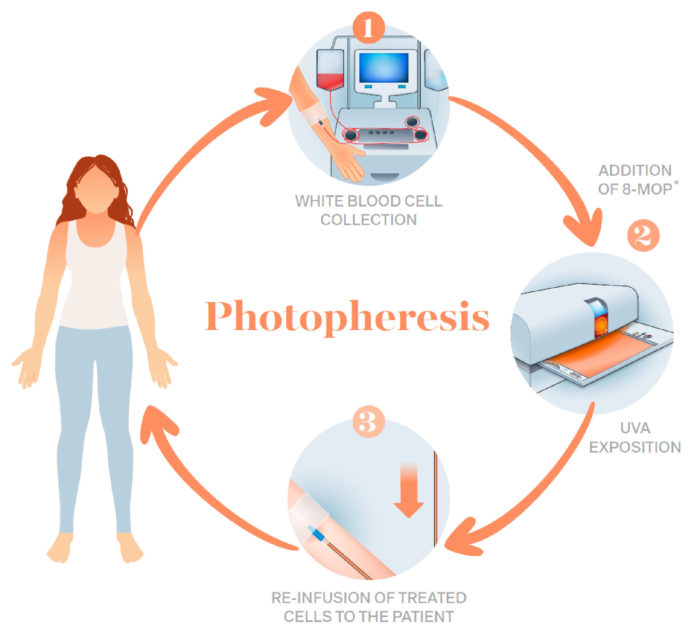Photopheresis is a form of apheresis and photodynamic therapy in which blood is treated with a photosensitizing agent and subsequently irradiated with specified wavelengths of light to achieve an effect.
Photopheresis, also known as extracorporeal photopheresis (ECP), is a medical treatment that removes blood via a machine and isolates white blood cells. Then, these white cells are exposed to a medication called 8-methoxypsoralen followed by UVA irradiation before returning the blood to the patient.

These white cells are targeted because they are underlying cause of disease. In the case of cutaneous T-cell lymphoma, the white cells are abnormal. In other diseases, the white cells are responsible for an immune response which causes transplant rejection or graft versus host disease. Photopheresis is used to treat the following medical conditions:
- Lung transplant rejection
- Heart transplant rejection
- Chronic graft versus host disease (GVHD)
- Cutaneous T-cell lymphoma (CTCL)
Photopheresis (FOH-toh-feh-REE-sis), or extracorporeal photoimmune therapy, is a procedure that treats graft versus host disease (GVHD, a disease caused when donated stem cell graft attacks normal tissue) or cutaneous T-cell lymphoma (CTCL).
During photopheresis, some of your blood is taken from your vein. Your white blood cells are then separated from the other cells in your blood. Your white blood cells are treated with a medication called methoxsalen, exposed to ultraviolet (UV) light, and then put back in your vein, along with your other blood cells. These treated cells help your immune system fight GVHD and CTCL.
New uses for Photopheresis, a cellular immunotherapy – Yale Medicine
Photopheresis: A Cancer Treatment
Photopheresis is a blood-filtering therapy that works with your immune system to help the body heal itself. Richard Edelson, MD, Yale Medicine’s chair of Dermatology, developed this form of immunotherapy in the 1980s to treat cutaneous T-cell lymphoma (CTCL)—a cancer that starts in the skin and potentially spreads to the blood, lymph nodes and other internal organs. Over time, the therapy has been shown to effectively treat other autoimmune issues, including graft-versus-host-disease (GVHD) and organ transplantation rejection.
THERAKOS Photopheresis
THERAKOS Photopheresis is the only FDA-approved photopheresis system. It is a systemic treatment indicated for the palliative treatment of CTCL skin.

The THERAKOS Photopheresis System is an immunomodulatory therapy that uses extracorporeal photopheresis (ECP) to help enhance immunologic response.* THERAKOS Photopheresis was first approved by the FDA in 1987 for the palliative treatment of CTCL skin symptoms in patients who were not responsive to other types of treatment.
The CELLEX instrument is a sophisticated instrument that is part of an integrated, closed photopheresis system. Only healthcare professionals who have special training and experience in the THERAKOS CELLEX Photopheresis System should operate the CELLEX instrument.4 Healthcare professionals with a background in apheresis are the most common CELLEX operators. Please read the appropriate Operator’s Manual before using this product.
